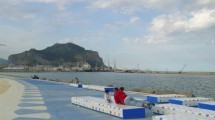Abstract
This research aims to address the relationship between “the city of care” and interior spaces in relation to the health care emergency that has partially—or substantially—changed our understanding of the design of spaces.
Access this chapter
Tax calculation will be finalised at checkout
Purchases are for personal use only
Similar content being viewed by others
Notes
- 1.
These aspects were highlighted as part of the course The city of care, by professors Anna Anzani and Francesco Scullica, with Giulio Capitani, Elena Elgani, Emilio Lonardo, held since the a.y. 2020–21 at the School of Design of Politecnico di Milano. Within the framework of these course through the contribution of specialist speakers from different disciplines, it emerged not only the importance of the topic in relation to design, but also the fundamental role of connection and integration that design is called to play toward other disciplines.
- 2.
One particularly interesting example of loft in the Italian context is that designed in an abandoned theatre by Lissoni & Partners from 2006 to 2008 in Monza, Italy. More information and pictures are retrievable at this link: https://www.lissoniandpartners.com/en/interiors/residential/europe/completed/private-loft-monza/35.
- 3.
The theme of interconnectedness in the house has been explored in Italian architecture since the 50 s: architect Giò Ponti, especially in his apartment in Via Dezza (1957) but also in many other of his residential projects, used to imagine apartments as a single, vast room (only the service rooms are closed off) that in Via Dezza comes to encompass even the bedrooms and the study, in the unbroken continuity of the reinforced open floor plan of the same diagonally striped ceramic floor.
- 4.
An interesting approach to (partially) overcome this issue comes from flexible spatial layouts obtained by moving walls or other elements: a case study in that regard is the 29 sqm Taaac! apartment in Milan, where a moving wall with integrated furniture continuously redesigns the fruition of the space. https://atomaa.eu/it/taaac/.
- 5.
Among many other examples, we can cite the concept sofa L20 by Jak design studio, where the couch can easily become a secluded workspace or large bed according to the needs of the dweller https://jakstudio.co.uk/l20-sofa/.
- 6.
In this regard, architect Carlo Ratti and his team designed a portable wardrobe ozone purifier (not yet in production), perfect to be placed in entryways, called Pura-Case. https://carloratti.com/project/pura-case/..
- 7.
The cited online conference “New Digital Art Day: il ruolo del design nell’era digitale” took place on the 20th of November, 2020. https://www.eventi.polimi.it/wp-content/uploads/2020/10/NEW-DIGITAL-ART-DAY-programma.pdf.
- 8.
An important case study on imagining new green spaces in buildings is The Commons, by Breathe Architecture, in Melbourne (AUS): it is a multi-residential property that, through shared amenities and spaces such as the green roof, aims at creating a community of dwellers. https://thelocalproject.com.au/galleries/commons-breathe-architecture-project-architecture-east-brunswick-vic-australia/.
- 9.
Giò Ponti’s Finestra Arredata was his way to regain as habitable space the “fourth-wall” of a room; the furnished window was first designed in the first half of the 50 s, and reached its maximum expression in his house in Via Dezza, Milano. For more information and pictures: https://www.gioponti.org/it/archivio/scheda-dell-opera/dd_161_6227/progetto-di-finestra-arredata.
References
Alibegovic M, Cavalli L, Lizzi G, Romani I, Vergalli I (2020) Covid 19 & SDGs: Does the current pandemic have an impact on the 17 sustainable development goals? A qualitative analysis. Fondazione Eni Enrico Mattei, Milano. Accessed May 2021, from: https://www.feem.it/m/publications_pages/brief07-2020.pdf
Boeri C (1987) Le dimensioni umane dell’abitazione. Franco Angeli, Milan
Chayka K (2020) How the coronavirus will reshape architecture. The New Yorker. Accessed May 2022, from https://www.newyorker.com/culture/dept-of-design/how-the-coronavirus-will-reshape-architecture
Corso M (2020) Smart working during the time of the Coronavirus. Politecnico di Milano—School of Management. Accessed September 2021, from: https://www.som.polimi.it/lo-smart-working-ai-tempi-del-coronavirus/
Dominici L (2020) Più scanner e meno touch nell’hotellerie del dopo Covid. Il Sole 24 Ore. Accessed May 2022, from: https://www.ilsole24ore.com/art/piu-scanner-e-meno-touch-nell-hotellerie-dopo-covid-AD1LPUM
EPA—U.S. Environmental Protection Agency (2021a) Indoor air in homes and coronavirus (COVID-19) Report. Accessed May 2022, from: https://www.epa.gov/coronavirus/indoor-air-homes-and-coronavirus-covid-19
EPA—U.S. Environmental Protection Agency (2021b) Indoor Air Quality. Reports on the Environment. Accessed May 2022, from: https://www.epa.gov/report-environment/indoor-air-quality
Milano T (2019) Broken nature: design takes on human survival|Triennale Milano. XXII Triennale—Exhibition. Accessed from: https://triennale.org/eventi/broken-nature/
Monchiero U, Scullica F (2021) Ospitalità Post-Covid; Implementare l’offerta dell’ospitalità italiana, valorizzando le potenzialità nello scenario Post-covid 19: il ruolo del design. [Lecture presentation]. Guest/Lab: new trends in hospitality design and contract, Milan, IT. https://www.guestlab.it/programma2021/
Morens DM, Fauci AS (2020) Emerging pandemic diseases: how we got to COVID-19. Cell J 182(5):1077–1092. Accessed from: https://www.cell.com/cell/pdf/S0092-8674(20)31012-6.pdf
Ordieres Meré J, Vergara Gonzàlez E, Alba Elìas F, Pernìa Espinoza A (2008) Acoustic design criteria as a relevant factor for architectural projects. Universidad de La Rioja. Accessed July 2021, from: https://www.arauacustica.com/files/publicaciones_relacionados/pdf_esp_312.pdf
Redazione ANSA (2020) Smart Working, quarantena, e il futuro dell’abitare. ANSA.it. Accessed May 2022, from: https://www.ansa.it/canale_lifestyle/notizie/design_giardino/2020/04/11/smart-working-quarantena-e-il-futuro-dellabitare_06ea9767-ba7f-408c-b68f-6b2a6f0ba02a.html
Schneider A (2021) Materiality in a post-COVID-19 World. ArchDaily—Articles. Accessed July 2021, from: https://www.archdaily.com/964664/materiality-in-a-post-covid-19-world
Scullica F (2020) Le nuove sfide dell’interior design. Arte Cultura Magazine—Ili Editore. Accessed May 2022, from: https://ilieditore.com/arte-cultura/le-nuove-sfide-dellinterior-design/
Scullica F, Elgani E (2019) The response of the design world to the current changes: hybridization of functional spaces and definition of new spatial typologies. In: Elgani EM, Scullica FA (Eds) Living, working and travelling – new processes of hybridization for the spaces of hospitality and work. Franco Angeli, Milan
Scullica F, Elgani E (2020) Italian design day: workplaces for sustainable futures. Italian Institute of Culture—Oslo. Accessed May 2022, from: https://iicoslo.esteri.it/iic_oslo/nb/gli_eventi/calendario/la-giornata-del-design-italiano.html
Scullica F, Elgani E, Monchiero U (2021a) Sustainable community workspaces in the post COVID-19 era [Paper presentation]. Webinar: interiors in the era of COVID-19. MIRC—Kingston School of Arts, London, UK. https://www.kingston.ac.uk/events/item/3790/24-mar-2021a-interiors-in-the-era-of-covid19/
Scullica F, Elgani E, Monchiero U (2021b) The relevance of color in post COVID-19 interior design. In AIC (ed) Proceedings of the international colour association (AIC) conference 2021b, pp 849–854. Accessed May 2022, from: https://aic-color.org/resources/Documents/Proceedings_AIC2021b_r10.pdf
WHO—World Health Organisation (2020) Cleaning and disinfection of environmental surfaces in the context of COVID-19. Accessed June 2021, from: https://apps.who.int/iris/bitstream/handle/10665/332096/WHO-2019-nCoV-Disinfection-2020.1-eng.pdf
Author information
Authors and Affiliations
Corresponding author
Editor information
Editors and Affiliations
Rights and permissions
Copyright information
© 2023 The Author(s), under exclusive license to Springer Nature Switzerland AG
About this chapter
Cite this chapter
Scullica, F., Monchiero, U. (2023). Post-COVID Interiors in the City of Care. In: Anzani, A., Scullica, F. (eds) The City of Care. Springer Series in Design and Innovation , vol 26. Springer, Cham. https://doi.org/10.1007/978-3-031-14608-4_3
Download citation
DOI: https://doi.org/10.1007/978-3-031-14608-4_3
Published:
Publisher Name: Springer, Cham
Print ISBN: 978-3-031-14607-7
Online ISBN: 978-3-031-14608-4
eBook Packages: EngineeringEngineering (R0)




